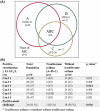Allergic sensitization to lipocalins reflects asthma morbidity in dog dander sensitized children
- PMID: 35510076
- PMCID: PMC9058535
- DOI: 10.1002/clt2.12149
Allergic sensitization to lipocalins reflects asthma morbidity in dog dander sensitized children
Abstract
Background: Sensitization to dog is an important risk factor for asthma in children, but the clinical relevance of IgE to available dog- and furry animal allergen molecules is uncertain.
Methods: Spirometry, methacholine challenge, fraction of exhaled nitric oxide, nasal challenge with dog extract and questionnaires were performed in 59 dog-sensitized children (age 10-18 years). Serum IgE to dog-, cat-, horse extracts and the allergen molecules Can f 1-6, Fel d 1, Fel d 2, Fel d 4 and Equ c 1 were evaluated.
Results: Median numbers of positive IgE results to furry animal allergen molecules among children without asthma was 3, with asthma 5.5 and with troublesome asthma 9 (asthma vs. no asthma; p = 0.039; troublesome asthma vs. no asthma; p = 0.009). The odds ratio for asthma if sensitized to any lipocalin was 7.2 (95% confidence Interval: 1.44-35.9). Children with troublesome asthma had higher IgE levels to the lipocalins Can f 2, Can f 4 and Can f 6 compared to the rest of the study population (44 vs. 4.1 kUA/L, p = 0.015; 5.8 vs. 0.9 kUA/L, p = 0.018 and 1.3 vs. 0.7 kUA/L, p = 0.03 respectively). Furthermore, a positive nasal challenge was more common among children with troublesome asthma (83% vs. 36%, p = 0.036).
Conclusions: Polysensitization to furry animal allergens and lipocalins is associated with asthma in dog-sensitized children. Children with troublesome asthma have higher IgE levels to several dog lipocalins than other dog sensitized children.
Key message: Polysensitization to furry animal allergens and high IgE levels to the dog lipocalins Can f 2, Can f 4 and Can f 6 is associated with asthma severity in dog dander sensitized children. Molecular allergy diagnostics may thus help the clinicians to evaluate the impact of allergic sensitization on asthma morbidity.
Keywords: allergen molecules; asthma; can f; children; dog allergy; lipocalins; nasal provocation testing.
© 2022 The Authors. Clinical and Translational Allergy published by John Wiley & Sons Ltd on behalf of European Academy of Allergy and Clinical Immunology.
Conflict of interest statement
Ulrika Käck report personal fees from Thermo Fisher Scientific, outside the submitted work. Marianne van Hage report personal fees from Thermo Fisher Scientific, outside the submitted work. Anna Asarnoj report personal fees from Meda/Mylan, Orion Pharma, ALK and Thermo Fisher Scientific outside the submitted work. Jon R. Konradsen has received material from Thermo Fisher to perform the IgE analysis in this project. Hans Grönlund and Gunnar Lilja declare that they have no relevant conflicts of interest.
Figures



Similar articles
-
Furry Animal Allergen Component Sensitization and Clinical Outcomes in Adult Asthma and Rhinitis.J Allergy Clin Immunol Pract. 2019 Apr;7(4):1230-1238.e4. doi: 10.1016/j.jaip.2018.12.018. Epub 2018 Dec 27. J Allergy Clin Immunol Pract. 2019. PMID: 30594587
-
Characterization of sensitization to furry animal allergen components in an adult population.Clin Exp Allergy. 2019 Apr;49(4):495-505. doi: 10.1111/cea.13355. Epub 2019 Feb 27. Clin Exp Allergy. 2019. PMID: 30697845
-
Molecular allergy diagnostics refine characterization of children sensitized to dog dander.J Allergy Clin Immunol. 2018 Oct;142(4):1113-1120.e9. doi: 10.1016/j.jaci.2018.05.012. Epub 2018 May 29. J Allergy Clin Immunol. 2018. PMID: 29852259
-
Molecular diagnosis in cat allergy.World J Methodol. 2021 May 20;11(3):46-60. doi: 10.5662/wjm.v11.i3.46. eCollection 2021 May 20. World J Methodol. 2021. PMID: 34026578 Free PMC article. Review.
-
Structural similarities of human and mammalian lipocalins, and their function in innate immunity and allergy.Allergy. 2016 Mar;71(3):286-94. doi: 10.1111/all.12797. Epub 2015 Nov 23. Allergy. 2016. PMID: 26497994 Free PMC article. Review.
Cited by
-
Sensitization to molecular dog allergens in an adult population: Results from the West Sweden Asthma Study.Clin Exp Allergy. 2023 Jan;53(1):88-104. doi: 10.1111/cea.14216. Epub 2022 Sep 1. Clin Exp Allergy. 2023. PMID: 35984703 Free PMC article.
-
Systemic IL-26 correlates with improved asthma control in children sensitized to dog allergen.Respir Res. 2024 Apr 15;25(1):163. doi: 10.1186/s12931-024-02773-7. Respir Res. 2024. PMID: 38622712 Free PMC article.
References
-
- Curin M, Reininger R, Swoboda I, Focke M, Valenta R, Spitzauer S. Skin prick test extracts for dog allergy diagnosis show considerable variations regarding the content of major and minor dog allergens. Int Arch Allergy Immunol. 2011;154(3):258‐263. - PubMed
-
- Wintersand A, Asplund K, Binnmyr J, et al. Allergens in dog extracts: implication for diagnosis and treatment. Allergy. 2019. - PubMed
LinkOut - more resources
Full Text Sources
Miscellaneous

